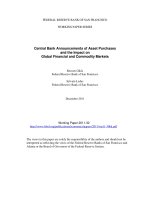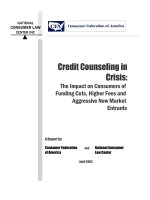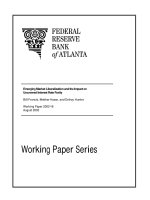Financial accounting the impact on decision makers 9e chapter 10
Bạn đang xem bản rút gọn của tài liệu. Xem và tải ngay bản đầy đủ của tài liệu tại đây (2.83 MB, 44 trang )
Chapter 10
Long-Term Liabilities
Long-Term Liabilities
Obligation
that will not be satisfied within one
year or the current operating cycle
Components:
Bonds
or notes payable
Leases
Deferred taxes
LO 1
Bonds Payable
A security or financial instrument that allows firms to
borrow large sums of money and repay the loan over a
long period of time
The borrower (issuing company) agrees to pay interest
on specific dates, usually semiannually or annually
The borrower also agrees to repay the principal at the
maturity, or due date, of the bond
Face value or par value: The denomination of the bond
is usually referred to as the face value or par value,
usually in denominations of $1,000
LO 2
Bonds Payable—Characteristics
Debenture
bonds: not backed by specific collateral
Secured bond: the certificate indicates specific
assets that serve as collateral in case of default
Term
bonds: entire principal amount is due on a
single date
Serial bonds: a portion of the bonds comes due each
time period
Bonds Payable—Characteristics
(continued)
Convertible
bonds: can be converted into common
stock at a future time
Callable
bonds: redeemed or retired before their
specified due date
Exhibit 10.2—Bond Certificate
Factors Affecting Bond Price
Face
rate of interest: also called stated rate,
nominal rate, contract rate, coupon rate
The rate of interest on the bond certificate
Market rate of interest: also called effective rate,
bond yield
The rate that investors could obtain by investing in
other bonds
Bond
issue price: the present value of the
annuity of interest payments plus the present
value of the principal
LO 3
Premium or Discount on Bonds
If Market Rate = Face Rate
issued at face value
If Market Rate > Face Rate
issued at a discount
Discount = Face Value − Issue Price
If Market Rate < Face Rate
issued at a premium
Premium = Issue Price − Face Value
The relationship between interest rates and bond prices is
always inverse
LO 4
Recording Bond Issuance at Discount
Discount Firm could identify and analyze the effect of the
issuance of the bonds as follows:
Recording Bond Issuance at Discount
(continued)
The Discount on Bonds Payable account is shown as a contra
liability on the balance sheet as a deduction from Bonds
Payable. If Discount Firm prepared a balance sheet immediately
after the bond issuance, the following would appear in the LongTerm Liabilities category of the balance sheet:
Example 10.2—Calculating Bond
Issuance at a Premium
On January 1, 2014, Premium Firm wants to issue the same bonds as in
Example 10-1: $10,000 face value bonds with an 8% face rate of interest and
with interest paid annually each year for four years. Assume, however, that
the market rate of interest is 6% for similar bonds. The issue price is
calculated as the present value of the annuity of interest payments plus the
present value of the principal at the market rate of interest. The calculations
are as follows:
We have calculated that the bonds would be issued for $10,693. The amount
of the premium is calculated as follows:
Bond Issuance at a Premium
Premium Firm could identify and analyze the effect of
the issuance of the bonds as follows:
Bond Issuance at a Premium
The account Premium on Bonds Payable is an addition
to the Bonds Payable account. If Premium Firm
presented a balance sheet immediately after the bond
issuance, the Long-Term Liabilities category of the
balance sheet would appear as follows:
Bond Amortization
Process
of transferring an amount from the
discount or premium account to interest
expense each time period
Effective interest rate: produces a constant
effective interest rate from period to period
Effective Rate = Annual Interest Expense/Carrying Value
Carrying
value:
• Carrying Value = Face Value − Unamortized Discount OR
• Carrying Value =Face Value + Unamortized Premium
LO 5
Exhibit 10.4—Discount Amortization:
Effective Interest Method of
Amortization
Example 10.3—Recording Amortization
of Discount
Exhibit 10-4 is the basis for determining the effect of amortization on the
firm’s financial statements
Amortization of Discount
On the balance sheet presented as of December 31,
2014, the unamortized portion of the discount appears
as the balance of the Discount on Bonds Payable
account as follows:
Exhibit 10.5—Premium Amortization:
Effective Interest Method of
Amortization
Example 10.4—Recording Amortization
of a Premium
Exhibit 10-5 is the basis for determining the effect of
amortization of a premium on the firm’s financial statements.
Premium Firm could identify and analyze the effect of the
payment of interest and amortization of premium as follows:
Amortization of a Premium
In Example 10-4, the December 31, 2014, balance
represents the amount unamortized, or the amount
that will be amortized in future time periods. On
December 31, 2014, the unamortized portion of the
premium appears as the balance of the Premium on
Bonds Payable account as follows:
Redemption of Bonds
Retirement
of bonds by repayment of the
principal
If redeemed at maturity, no gain or loss occurs
If retired before maturity, a gain or loss occurs
Gain = Carrying Value − Redemption Price
Loss = Redemption Price − Carrying Value
The
gain or loss on bond redemption is shown
on the income statement
LO 6
Liability for Leases
Contractual
arrangement between two parties
Allows
the lessee the right to use an asset in
exchange for making payments to its owner, the
lessor
A common example of a lease arrangement is the
rental of an apartment
• The tenant is the lessee, and the landlord is the lessor
LO 7
Liability for Leases
Operating
lease: off-balance-sheet financing
The
lessee acquires the right to use an asset for a
limited period of time
The lessee is not required to record the right to use
the property as an asset or record the obligation for
payments as a liability
Capital lease:
Recorded as an asset
by the lessee
The lessee has the right of ownership and control
Criteria for Lease Capitalization
One or more of the following criteria must be met:
Transfer of ownership of property to the lessee at the
end of the lease term
Contains a bargain-purchase option to purchase the
asset for lower than its fair market value
The lease term is 75% or more of property’s economic
life
The present value of payments is 90% or more of
property’s fair market value at the inception of the
lease
Exhibit 10.6—Gap, Inc.’s 2011 Note
Disclosure of Leases
Although operating leases are not recorded on the balance sheet, FASB
requires note disclosure









